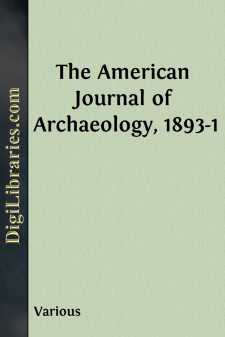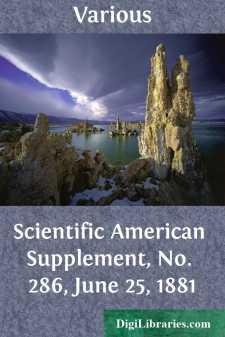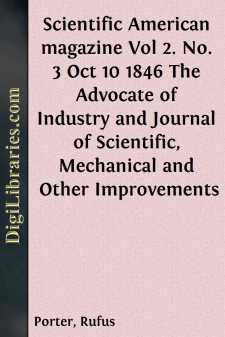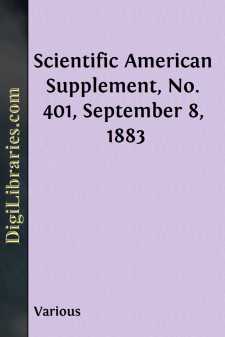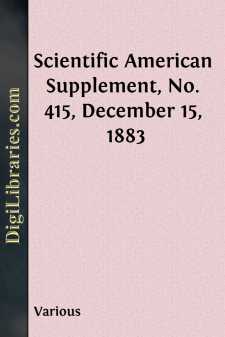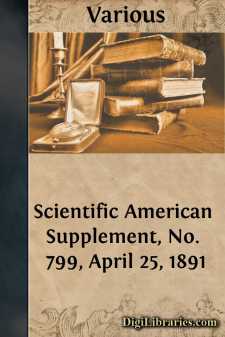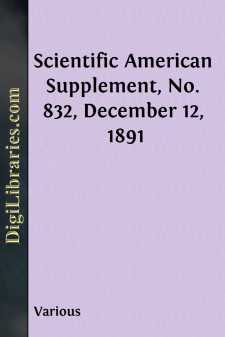Periodicals
- Art 27
- Children's periodicals 59
- Entertainment 5
- Food/Wine 2
- Games/Humor 455
- General 661
- Health 1
- History 53
- House/Home 1
- Regional 62
- Science/Nature
- Transportation 10
Science/Nature Books
Sort by:
by:
Harry Bates
here was no use hiding from the truth. Somebody had blundered—a fatal blunder—and they were going to pay for it! Mark Forepaugh kicked the pile of hydrogen cylinders. Only a moment ago he had broken the seals—the mendacious seals that certified to the world that the flasks were fully charged. And the flasks were empty! The supply of this precious power gas, which in an emergency should have been...
more...
by:
Various
THE TEMPLE ON THE ACROPOLIS BURNT BYTHE PERSIANS. The excavations conducted by the Greek Archæological Society at Athens from 1883 to 1889 have laid bare the entire surface of the Acropolis, and shed an unexpected light upon the early history of Attic art. Many questions which once seemed unanswerable are now definitively answered, and, on the other hand, many new questions have been raised. When, in...
more...
by:
Various
MR. E. H. PLUMACHER, U. S. Consul at Maracaibo, sends to the State Department the following information touching the wealth of coal and petroleum probable in Venezuela: The asphalt mines and petroleum fountains are most abundant in that part of the country lying between the River Zulia and the River Catatumbo, and the Cordilleras. The wonderful sand-bank is about seven kilometers from the confluence of...
more...
by:
Rufus Porter
The New Roman Road. [The present Pope has given his consent to build railroads in his dominions, which the former Pope was averse to. The following lines are predicated on his consent.]Ancient Romans, ancient Romans—Cato, Scipio Africanus,Ye whose fame's eclips'd by no man's,Publius Æmilianus,Sylla, Marius, Pompey, Cæsar,Fabius, dilatory teaser,Coriolanus, and ye GracchiWho gave so...
more...
by:
Various
IS THE SINNER A MORAL AGENT IN HIS CONVERSION? There are a great many questions asked upon the subject of conversion, and as many answers given as there are theories of religion, and many persons listening to men's theories upon this subject are left in doubt and darkness in reference to what is and is not conversion. You ask the Mormons, who fully believe their theory of conversion, and they will...
more...
by:
Various
MONUMENT TO CHRISTOPHER COLUMBUS, AT BARCELONA, SPAIN. The cultivated and patriotic city of Barcelona is about to erect a magnificent monument in honor of Columbus, the personage most distinguished in the historic annals of all nations and all epochs. The City of Earls does not forget that here the discoverer of America disembarked on the 3d of April, 1493, to present to the Catholic monarchs the...
more...
by:
Various
In consequence of the interest that has been recently excited on the subject of bread reform, we have, says the London Miller, translated the interesting contribution of H. Mège-Mouriès to the Imperial and Central Society of Agriculture of France, and subsequently published in a separate form in 1860, on "Wheat and Wheat Bread," with the illustration prepared by the author for the...
more...
by:
Various
THE GERMAN NATIONAL MONUMENT.--WAR AND PEACE. In our SUPPLEMENT No. 412 we gave several engravings and a full description of the colossal German National monument "Germania," lately unveiled on the Niederwald slope of the Rhine. We now present, as beautiful suggestions in art, engravings of the two statues, War and Peace, which adorn the corners of the monumental facade. These figures are about...
more...
by:
Various
THE NEW GERMAN DISPATCH BOAT METEOR. In time of war the dispatch boats are the eyes of the fleet. It is their duty to reconnoiter and ascertain the strength of the enemy and to carry the orders of the commander. For this service great speed is of the utmost importance. As all nations have increased the speed of their war ships during the last few years, it has become necessary to build faster dispatch...
more...
by:
Various
ARCHÆOLOGICAL DISCOVERIES AT CADIZ. Those who have had the good fortune to visit Andalusia, that privileged land of the sun, of light, songs, dances, beautiful girls, and bull fighters, preserve, among many other poetical and pleasing recollections, that of election to antique and smiling Cadiz—the "pearl of the ocean and the silver cup," as the Andalusians say in their harmonious and...
more...



